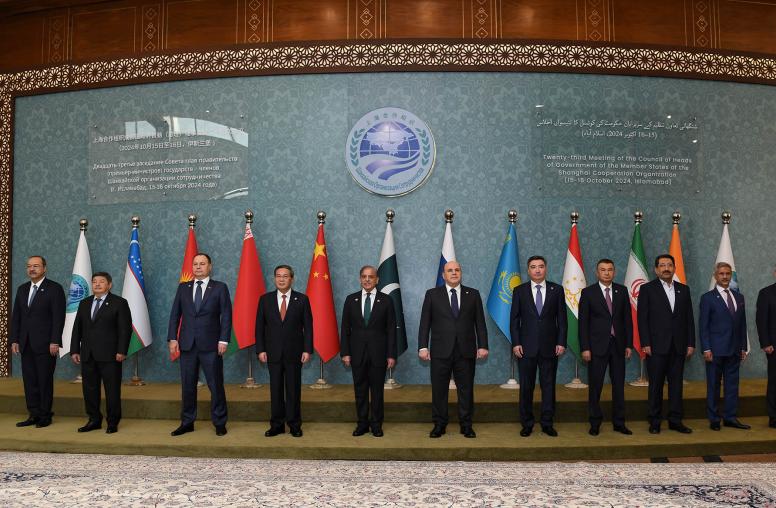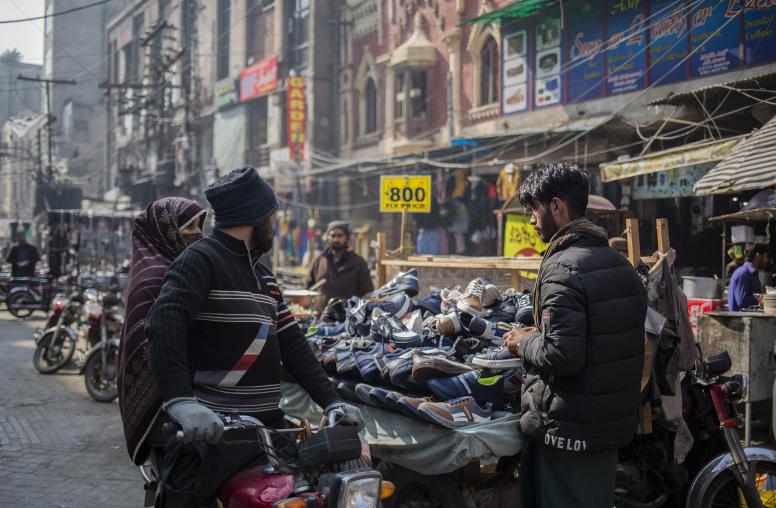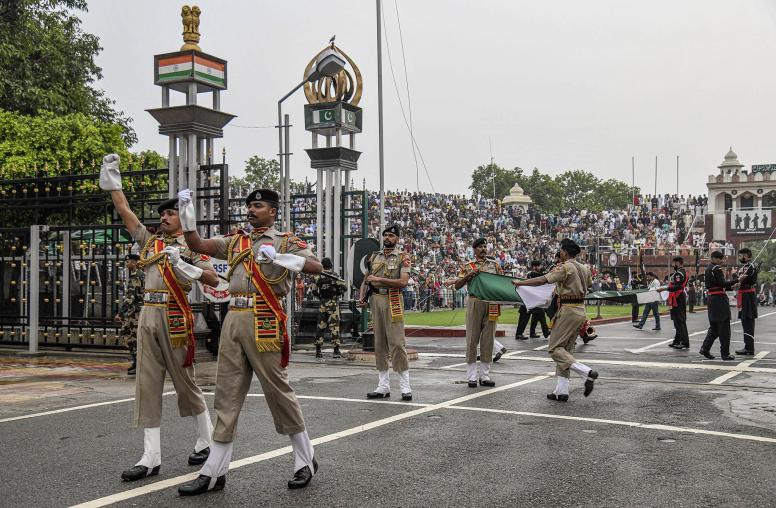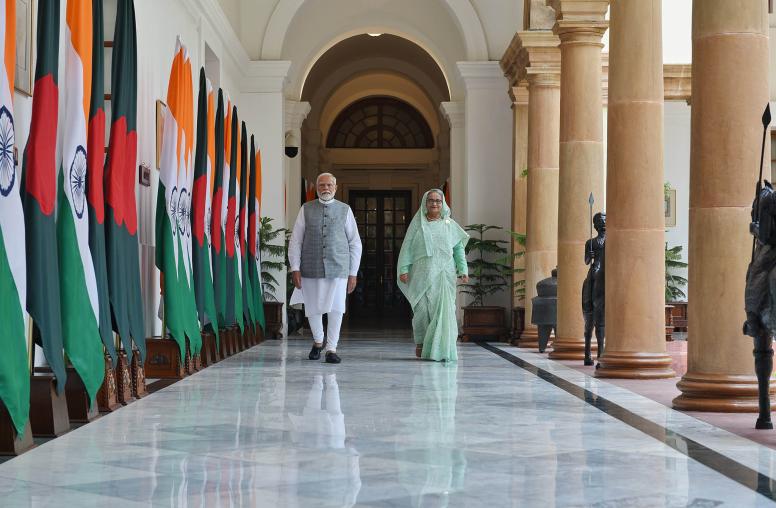Resolving the Pakistan- Afghanistan Stalemate
Afghanistan, Pakistan, and the neighboring regions would all benefit from a recognized open border between the two countries. What are the challenges to this objective?

Summary
- The Taliban and al Qaeda insurgencies today are equally active in Afghanistan and Pakistan. The nationalist insurgency in Pakistani Baluchistan, which Pakistani leaders assert receives support from Indian agents in Afghanistan, also aggravates relations between the two countries. The challenges of violent insurgency require both countries to address their relationship, particularly as it affects the border areas. Formation of such a policy is essential to the vital interests of the United States, NATO, and the international community, which has committed itself to the effort in Afghanistan through UN Security Council resolutions and other measures.
- Afghanistan and Pakistan have had largely antagonistic relations under all governments but the Taliban since Pakistan was created as part of the partition of India in 1947. Some elements of friction were also inherited from conflicts between Afghanistan and India when it was under British imperial rule. Afghanistan's governments, including that of the Taliban, have never recognized the Durand Line between the two countries as an international border and have made claims on the Pashtun and Baluch regions of Pakistan. Today 's cross-border insurgencies, with their sanctuaries and support networks in Pakistan, are nurtured by the same sources as previous conflicts, as well as global Islamist movements.
- Arrangements to secure the frontier of the British Empire in the nineteenth century by isolating Afghanistan as a buffer state do not work for a twenty-first-century borderland integrated into networks of global conflict. The United States and other external powers that seek to support the new order in Afghanistan and stabilize both Pakistan and Afghanistan should encourage a multidimensional process of dialogue and peacebuilding focused on the problems of the border region. Pressure may also be needed to convince some actors to engage seriously in such a process, but pressure alone will not succeed.
- A process should work toward reforms in the Federally Administered Tribal Areas (FATA) of Pakistan, leading to their integration into Pakistani national politics and administration; the recognition by Afghanistan of the international border; assured access by Afghanistan to Pakistani ports and transit facilities; the maintenance by both countries of open borders for trade, investment, and cultural relations; agreement by both countries and by India to keep the India-Pakistan dispute out of Afghanistan 's bilateral relations with both; and agreements on both sides to cease supporting or harboring violent opposition movements against the other.
- The United States, NATO, and the UN must agree to send a common message to Islamabad: that the persistence of Taliban havens in Pakistan is a threat to international peace and security that Pakistan must address immediately. They also must agree to urge Afghanistan and India to do all in their power to encourage Pakistan to make difficult decisions by addressing sources of Pakistani insecurity, including issues relating to the border region and Kashmir. They should actively promote this process and act as guarantors and funders of any agreements that result from it.
Introduction
On January 13, 2006, the sleepy village of Damadola in the Bajaur tribal district of Pakistan on the Afghan frontier became the focus of global attention. With the American news networks in the lead, global media broadcast coverage of the Central Intelligence Agency's attempt to kill al Qaeda's number two, Ayman al-Zawahiri, who had reportedly attended a dinner in the village to commemorate the Muslim holiday `Id-ul-Adha. Pictures of tribal members digging dead bodies from the debris of their bombed-out mud houses were beamed around the globe. Pakistan's Islamist political parties called for severing all ties with the United States for this attack on the country 's sovereignty (Reuters 2006). President Pervez Musharraf, who initially minimized the attack 's importance, later announced that at least five top al Qaeda figures had been killed, although al-Zawahiri himself had escaped (Khan 2006).
Three days later, in what appeared to be a reprisal, a suicide bomber riding a motorcycle blew himself up among spectators of a wrestling match in the southern Afghan town of Spin Boldak, across from the Pakistani border town of Chaman. It was Afghanistan's worst suicide attack, killing twenty-two civilians and leaving dozens more injured (Synovitz 2006).
This was the largest in a rash of suicide attacks in Afghanistan, some of which have taken place even in the relatively secure northern and western provinces (Qureshi and Sarwaryar 2006). With 1,500 violent deaths, more members of the Afghan security forces and the U.S.-led international coalition were killed in combat in 2005 than in any year since the overthrow of the Taliban regime in late 2001. In the first six months of 2006, Afghanistan faced thirty-two suicide attacks, unprecedented in the country 's three decades of violence (Karzai and Jones 2006). Since May 2006 violence has reached new levels. Some 800 insurgents, civilians, and soldiers died in the four southwestern provinces. The reorganized Taliban, operating in Afghanistan from bases in Pakistan, form the bulk of the insurgency, which also includes elements led by Afghan Islamist Gulbuddin Hikmatyar's Hizb-i-Islami and foreign jihadi forces, including the leadership of al Qaeda.
The violence, which has spread to both sides of the frontier, escalated in the run-up to President Bush's mid-March 2006 visit to South Asia--especially in Waziristan, a craggy region of 5,000 square miles divided into the South and North Agencies, or tribal districts. Some 300 Islamist militants, civilians, and Pakistani soldiers died in the fighting, which forced tens of thousands of people to flee the Pakistani town of Miran Shah, administrative headquarters of the North Waziristan tribal district. In neighboring South Waziristan, skirmishes, rocketing, assassinations, and land-mine blasts continue (Economist 2006). Since al Qaeda's retreat from Afghanistan in winter 2001, some tribal areas have become a small-scale copy of Taliban-controlled Afghanistan, where Islamist militants can recover and plan fresh operations while gradually imposing their will on the secluded region. Violence also has spread into the adjacent districts of the Northwest Frontier Province (Hussain 2006).
Recommendations and Conclusion
Afghanistan, Pakistan, and the neighboring regions would all benefit from a recognized open border between the two countries. Such a border would clarify that all Pashtuns have rights as citizens of one or another state and would enable them to communicate, trade, and develop both their economy and their culture in cooperation with one another. Such a settlement would strengthen democracy in both states and facilitate both Pakistan's access to Central Asia and Afghanistan's access to the sea. It would lessen domestic ethnic tensions and strengthen national unity in both states. It would, however, require difficult internal changes in both countries, a reversal of the hostility that has predominated in relations between the two governments for sixty years, and credible international guarantees.
A major challenge to such objectives is the Islamist insurgency on both sides of the border. In 2005 Musharraf responded to charges that the Taliban were engaging in cross-border activity by proposing to fence and mine the Durand Line, a solution reminiscent of the policies of Israel and Uzbekistan. As in Central Asia and the Middle East, such a solution will not work for many reasons. International political and military officials in Afghanistan, as well as counterinsurgency experts, agree that the key to strategic success is disrupting the Taliban's command and control, mainly in Quetta and Waziristan, not wasting resources on the impossible task of blocking infiltration by easily replaceable foot soldiers across snow-capped mountains and trackless deserts.6 Fencing would further isolate the border region and create an additional obstacle to its economic development.
Crafting a twenty-first-century border settlement will require ending the nineteenth-century regime in FATA. Since 9/11, Pakistan has ended FATA's autonomy by deploying 80,000 troops in the mountainous region, but these operations have not been matched by political and economic reforms. Stabilizing the border region must include the political integration of FATA into Pakistan. Almost all Pakistani political parties have urged reform packages. The extension to FATA of the Political Parties Act of 2002 would allow mainstream political parties to organize there and counter extremist propaganda. These parties would provide an opportunity for tribal members to campaign for their rights in national institutions.
The Awami National Party, one of the most vocal proponents of reforms in FATA, wants to overhaul the administrative and judicial system. It supports tribal representation in the legislature of an NWFP that would include FATA. The Awami National Party emphasizes the fact that in the 1960s and early 1970s FATA was represented in the provincial assembly of a united West Pakistan. Over the past decades, many tribal members have acquired farmland and businesses in the settled areas. They also obtain health care and education in NWFP's urban centers (Awami National Party 2006).
The Frontier Crimes Regulations have remained virtually unchanged since Lord Curzon promulgated their final version in 1901. Today human rights advocates and tribal intellectuals call for an overhaul of the law. They demand
- Conformity of the law to contemporary human rights standards;
- Transfer to parliament of all legislative and administrative powers over FATA now resting with the president;
- Extension of the jurisdiction of higher Pakistani courts to FATA and separation of the region's judiciary from the executive;
- Abolition of collective punishment and territorial responsibility;
- Extension of political and civic freedoms to FATA; and
- Implementation of a comprehensive disarmament and demobilization program in the region (Human Rights Commission of Pakistan 2005).
No reform program would be successful without a complementary strategy for economic development. It is crucial to reinforce reconstruction in Afghanistan with a compatible model across the border in FATA. The Awami National Party has asked for a detailed baseline survey by the World Bank or another international agency to assess the economic situation and help Pakistan and the people of FATA devise a comprehensive strategy. Linking FATA to Afghan reconstruction and creating special opportunity zones along the Durand Line will be first steps in this direction. Work is under way to establish such zones on the Afghan side. In May 2006 Musharraf hinted at establishing them with the help of the U.S. government. Such development would also open U.S. markets to products produced in FATA (Raza 2006).
FATA's isolation can be broken only by improving its infrastructure. A major highway spanning FATA, from Bajaur in the north to Waziristan and Zhob in the south, is needed to encourage contact. Pakistan's bilateral trade with Afghanistan now surpasses $2 billion a year (with Pakistani exports to Afghanistan totaling $1.2 billion, and Afghanistan's exports to Pakistan totaling $700 million).7 But so far there are only two official border crossings, Torkham in the north and Chaman in the south. At least a dozen more border crossings could be opened to facilitate trade.
More than seventy FM radio stations broadcast illegally in FATA, often inciting sectarian violence and hatred, but the region has not joined the telecommunication revolution in the rest of Pakistan. The area needs mobile telephony and Internet access. Trade and commerce also should be modernized by establishing tribal chambers of commerce and accounting and financial information systems. Since most of the land in the region is communal, there is a need for a baseline study of land rights and a strategy for reform. To accomplish this, the government should extend the municipal laws of land settlement to FATA. Proper utilization of several known mineral deposits in FATA will result in the growth of labor-intensive mining and manufacturing industries in marble and precious stones. Agriculture in general, and fruit in particular, can be made profitable by introducToday ing new techniques to tribal farmers and helping them gain access to markets (Awami National Party 2006).
Such a transformation requires complementary measures by Afghanistan, the United States, the UN, and NATO. The persistence of a safe haven for the Taliban insurgency in Pakistan threatens the objectives of the international community in Afghanistan. Success in Afghanistan is fundamental to the U.S. "war on terror," the UN's credibility, and NATO's viability. Forces whose command and control and networks of recruitment, funding, training, and equipment are located in Pakistan are killing Afghan, American, British, and Canadian troops and civilians. The United States, the UN, and NATO must agree quickly to send a message to Islamabad that the persistence of Taliban havens in Pakistan is, in the words of the UN Charter, a threat to international peace and security that Pakistan must address immediately.
The United States, UN, and NATO also must agree on sending a message to Afghanistan and India that they must do all in their power to encourage Pakistan to make such difficult decisions by addressing sources of Pakistani insecurity, including issues related to the border region and Kashmir. The international community must offer generous aid and support to Pakistan if it undertakes needed reforms in the governance of FATA and creates a development area along the border in coordination with the reconstruction effort in Afghanistan.
The United States should use its influence to impress on Pakistan the gravity of the risks it is taking by not disrupting the Taliban command and to persuade all governments in the region to lower the tone of confrontation. Only the United States is likely to be able to persuade Pakistan and Afghanistan to keep India out of their bilateral relationship by agreeing to a set of ground rules and to press India to abide by them. India's contribution to Afghanistan is welcome and mostly constructive, but it should reduce its staff and activities in the border regions for the sake of regional stability. The size of the Indian consulates should be limited and their roles strictly defined.
U.S. diplomacy prevented nuclear confrontations between India and Pakistan in 1999 and 2002 and helped these arch-rivals begin talking. It also should facilitate a political process between Pakistan and Afghanistan. The United States helped set up the tripartite commission composed of senior Afghan, Pakistani, and U.S. military officials in 2003; it now includes NATO but still deals only with military coordination. Until now, Pakistan has delayed responding to a proposal to expand the consultations to the political level. As part of their joint initiative, the United States and NATO need to press Pakistan for a positive response.
Afghanistan has more international backing and support than ever. A growing segment of opinion privately holds that now is the time to address these issues; but only leadership can encourage those harboring such ideas to propose them in public. The Karzai administration should take advantage of this situation to begin a national dialogue to develop a consensus on resolving the conflicts with Pakistan that have caused so much damage to both countries. Afghanistan needs to show good will to Pakistan regarding the border issue and make a historic compromise.
Both countries should facilitate and encourage people-to-people contact as well as contact between officials at all levels across the border. If the wars in Afghanistan had any positive impact it was to expose Afghans to the outside world. Nearly half of today's Afghan population has visited Pakistan at some point, making it the country that Afghans are most familiar with outside their homeland. About 60,000 Pakistanis currently work in Afghanistan, and 10,000 of them cross the border daily. Pakistan's exports to Afghanistan grew from $221 million in 2001 to $1.2 billion in 2006, but the economy in the border region faces a sharp decline. Despite the intimate contact of the two peoples, however, the governments remain isolated from each other. The governors and chief ministers of NWFP and Baluchistan should meet with counterparts in the Afghan border provinces regularly, as should police chiefs, customs officers, and other officials.
In 2006, no secessionist nationalist movement operates among the Pashtuns in Pakistan, and Afghanistan has not revived its irredentist claims. Tribes on both sides of the border are clamoring for development. Economic pressures have forced Pashtuns to migrate to Karachi and the Gulf region in huge numbers. Only policy changes in both Kabul and Islamabad can involve their Pashtun populations in mutual confidence building, which could lead to an amicable resolution of the border issue.
Three contending visions of relations between Pakistan and Afghanistan emerged in spring 2006. One was the launch of the friendship bus service between the eastern Afghan city of Jalalabad and the western Pakistani city of Peshawar. People in both countries celebrated the occasion and greeted the arriving delegations by showering them with rose petals, playing music, and dancing in joy (Agence France-Presse 2006). Another vision of cross-border relations was expressed in the rather implausible proposal of fencing the Durand Line (Pajhwok Afghan News 2006). A third and worrying trend is Talibanization and escalating violence in the areas around the Durand Line. People in both countries have chosen the peaceful alternative; now their governments and leaders should follow suit.
About the Report
The United States Institute of Peace has been working on the stabilization and reconstruction of Afghanistan since 2002. Institute initiatives focus on security, the rule of law, conflict resolution, building civil society, and education in Afghanistan and Afghanistan's relations with its neighbors. The Institute's Afghanistan Working Group, chaired by Dr. Barnett R. Rubin, is composed of government officials and nongovernmental organizations that discuss critical issues facing Afghanistan with top experts and policymakers and work directly to help the Afghan people build a peaceful and prosperous society.
The idea for this report started with discussions by Barnett Rubin with delegates to the Afghan constitutional Loya Jirga, President Hamid Karzai, and journalist Ahmed Rashid in December 2003. In spring and summer 2004 Abubakar Siddique conducted field work on the current positions of the diverse stakeholders in this complex region. During subsequent trips the coauthors carried out additional research, most recently in July-August 2006, when Rubin visited Afghanistan and Siddique visited Pakistan.
Grants from the Rockefeller Foundation, the Open Society Institute, the Royal Government of Norway, and the Government of the United Kingdom supported the research. The authors gratefully acknowledge the assistance of Afrasiab Khattak and Ahmed Rashid in Pakistan and Omar Zakhilwal, Rasul Amin, Hamed Wardak, and Humayun Hamidzada in Afghanistan. They also thank many anonymous informants and commentators from Pakistan, Afghanistan, and the United States. Ahmed Rashid, Marvin Weinbaum, and Sebastien Trives reviewed earlier drafts.
Dr. Barnett R. Rubin is chair of the Institute's Afghanistan Working Group and director of studies at the Center on International Cooperation at New York University. Abubakar Siddique is a journalist and Fulbright scholar who has covered Afghanistan, Pakistan, and Central Asia for many years.




